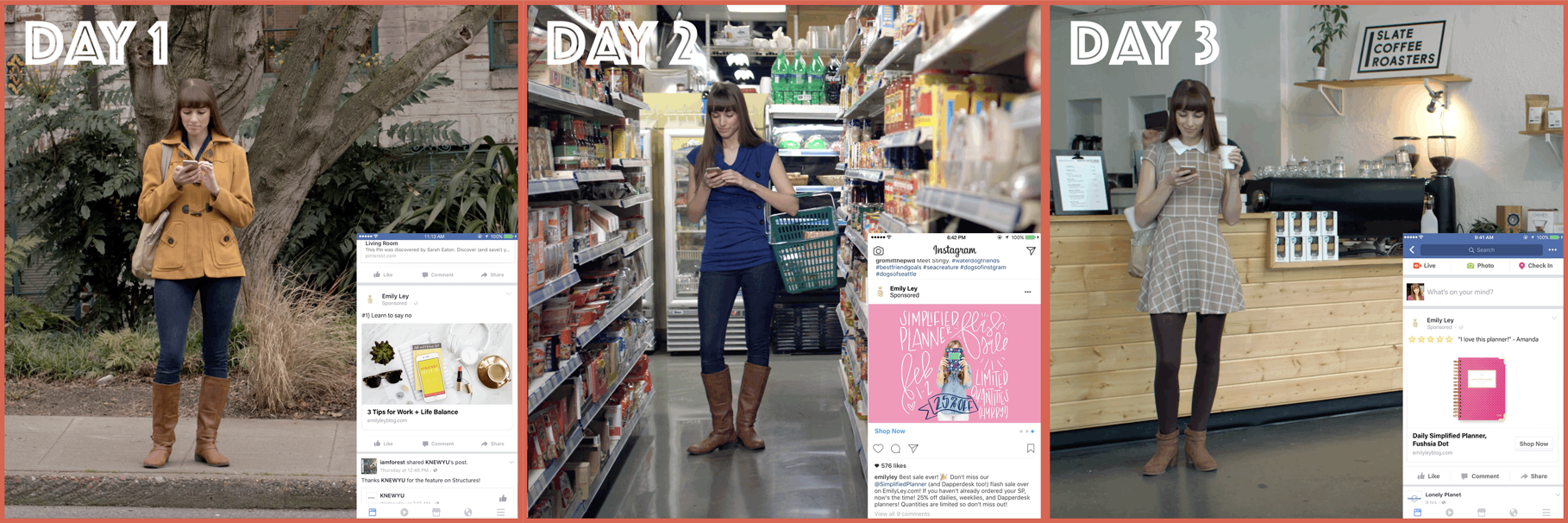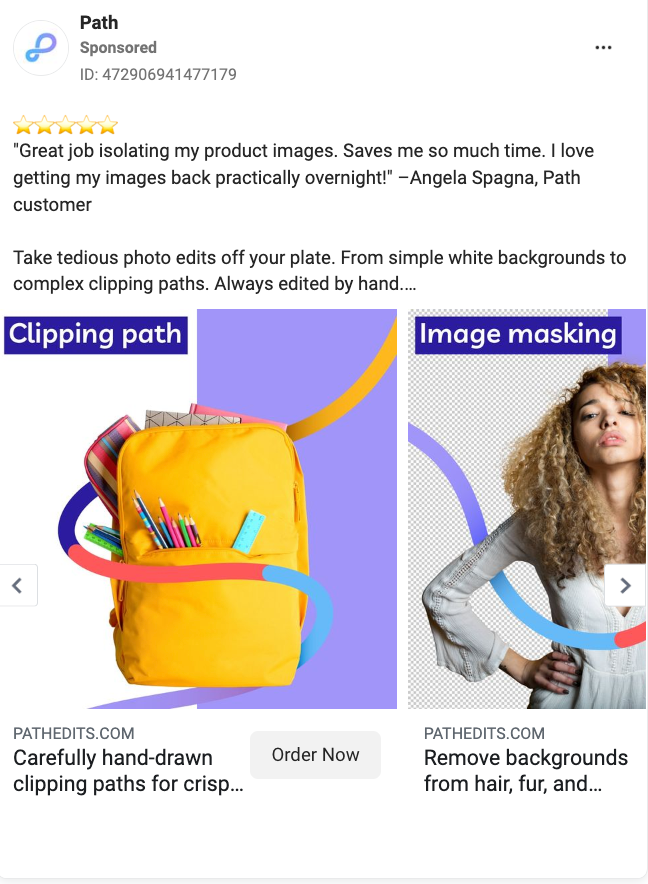Retargeting on Facebook with Google Ads and via other digital advertising channels gives prospects an opportunity to see your ad again (and again), effectively increasing your conversion rate. But poorly executed retargeting campaigns lead to wasted ad dollars and annoyed prospects. Though, when you’re starting and your site traffic is still limited, it’s perfectly fine to begin with generic retargeting.
But once your audience starts to grow, a sequential retargeting campaign is a better way to nurture prospects along the customer journey.
What is sequential retargeting?
Sequential retargeting is when your visitors go through a sequence of ad experiences after they leave your website. Instead of seeing the same repetitive retargeting ad, they will see a variety of ads as they move through the sequence.

Retargeting sequences are powerful because they:
- Fight ad fatigue: They keep the content fresh as visitors go through your sequence so your audience is more likely to engage with your ads.
- Nurture prospects: Your sequence can address the various objections a prospect may have about buying from your brand. (e.g., talk about your generous return policy, share positive reviews from other customers, etc.).
- Stand out by blending in: Each time your prospect scrolls through their social feed they expect to see new and interesting content. Your messages will stand out from other boring ads by blending into the dynamic nature of the social feed.
How did iOS 14 change sequential retargeting?
The latest iOS 14 updates have changed the game when it comes to targeted ads. Now, users can opt out of app-tracking advertising platforms like Facebook and TikTok—and many are taking advantage of that choice.
This means fewer data signals to train the algorithm how to find your customers and smaller attribution windows for website conversions. This affects reporting and reduces the ability to track site visitors to build retargeting audiences.
What sequential retargeting looks like in action
Pre–iOS 14, it was best to combine behavioral and sequential retargeting to create different retargeting sequences for prospects at various stages of the funnel. A visitor who left your store without having viewed a product is nowhere near as ready to buy as a prospect who abandoned a cart, for example. So your retargeting strategy would account for this with Facebook ads tailored to nurture prospects at each stage of the funnel.
In other words, you’d set up a sequence for prospects who bounced from the homepage, a sequence for prospects who viewed a product, and so on. But the iOS 14 updates limit the ability to get granular, so it’s important to broaden your targeting strategy when developing your ad creative.
Here are some ideas for what you might include in a retargeting sequence:
Blog post ad
You might show this first ad within a day of the visitor leaving your site, even as soon as a few hours. The content should be informative, entertaining, or meet some other need.
The example below from skin care brand 100% Pure promotes a blog post called “Why Everyone Should Have a Vitamin C Serum.” It’s a piece of content that positions 100% PURE as an expert in its space.

Email signup ad
You can use sequential retargeting to build your email list. Email marketing is an effective tool because it’s one of the few channels where you truly own your audience. Instead of having to earn or pay for an audience as you do on social media or other ad channels, you own your email list. So you can send those people an email whenever you want, without being subjected to algorithms or competitive bidding structures.
Many advertising platforms offer tools to create a newsletter signup form directly within the ad—no need to send users off-page to fill out a form on a landing page. You can then use email marketing strategies to continue the relationship and take advantage of potentially more cost-effective marketing channels.
This ad should be earlier on in the sequence, while your brand is still top-of-mind.
Product roundup ad
Creating a roundup or group of products is a great way to add sales-centric ads to your sequence. This should come after your top-of-funnel ad(s). This ad from photo editing studio Path, for example, highlights its collection of edits customers can order.

To create a group of products to include in your ad, you might consider a roundup of bestsellers. You could also group by product collection or category, bundle products together (such as shoes, a top, and jewelry to create an outfit), or highlight back-in-stock inventory. During the holidays, gift guides also work particularly well.
Sequential retargeting strategies for post–iOS 14
Paid ads used to be one of the most effective ways to drive high-quality traffic and sales for your online store. But increased competition and rising costs have driven this advertising channel to be less effective. Now, merchants have to be strategic if they want paid ads to deliver return on investment (ROI).
Broaden your retargeting sequences for website visitors
Granular site tracking is no longer the norm, and brands face more limitations when it comes to conversion events. While targeted personalized ad campaigns are most effective, these stipulations hinder a business’s ability to effectively execute said ads.
This is where broader targeting and audiences come into play. Rather than getting super specific, you’ll need to appeal to a wide variety of users and behaviors with your messaging and ads.
Invest in on-platform engagement for retargeting
Despite limitations from the iOS 14 update, social platforms can still track behavior on those platforms—this includes interactions between social profiles, content, and brands. That’s why it’s a good idea to invest in building these engagements so social platforms can collect data to allow you to create more effectively run sequential retargeting campaigns. From there, you can build engagement-based custom audiences.
For your top-of-funnel touch points, leverage video ads. Video is a high-performing content format that captures users’ attention. It’s a great foundation for building a strong relationship with your audience. Video can also work for more sales-driven ads, like this TikTok ad from Golde:

Remember to focus on your messaging. Tell a compelling story around the features and benefits of what you’re selling and how it can help your customers fulfill their aspirations. And finally, offer an easy way for customers to purchase your product—like the Facebook and Instagram ad example below from Golde, promoting its Beauty Matcha Bundle.

You can do the same with the Shopify integration with Facebook and Instagram to allow for direct sales when advertising on those channels.
Convert on the first visit and remarket through other channels
With more limitations comes the opportunity to explore other channels. Email marketing and SMS (text message) marketing are two channels where you truly own your audience—and you can remarket to them however you see fit.
Automated emails and SMS campaigns work for a variety of use cases: you can create an abandoned cart series, a welcome sequence for first-time customers, and a product recommendation ad campaign.
662 Bodyboard Shop sends an automated abandoned cart email when a shopper doesn’t complete their purchase. The brand could build out its remarketing emails even further by including incentives to complete the purchase in an abandoned cart email sequence or recommending complementary products for those who do convert.

To do this, ensure you’re capturing some information at the first touch point, be it an email or phone number. This strategy also works well for post-purchase campaigns to drive customer retention.
Use sequential retargeting to boost sales
If your approach to retargeting has been simply to set up a dynamic product ad and just let it run, you’re missing out on a whole lot of opportunities to improve your campaigns and increase your conversion rates.
Remember these key points:
- Your past visitors are going to leave at different stages of the funnel, so communicate with them accordingly.
- People hate repeatedly seeing the same content in their social feeds—use sequences to keep your ads fresh.
- Success of a funnel-driven retargeting sequence isn’t always measured in ROAS (return on ad spend)—keep that in mind as you assess performance of your campaigns.
If you have any questions about sequential retargeting, or Facebook ads in general, leave a comment below.
Sequential retargeting FAQ
What is sequential retargeting?
Sequential retargeting is when your visitors go through a sequence of ad experiences after they leave your website. Instead of seeing the same repetitive retargeting ad, they’ll see a variety of ads as they move through the sequence.
What is sequential advertising?
Sequential advertising is when your visitors go through a sequence of ad experiences after they leave your website. Instead of seeing the same repetitive ad, they’ll see a variety of ads as they move through the sequence.
What are the different types of retargeting?
- Generic
- Behavioral
- Sequential
How does sequential messaging work?
Sequential messaging works by building on the messaging from the last touch point to further tell a story and capture users’ attention. It involves a series of ads or communications from a business, which are then shown to its target audience.
Topics:
Join 446,005 entrepreneurs who already have a head start.
Get free online marketing tips and resources delivered directly to your inbox.
Thanks for subscribing
You’ll start receiving free tips and resources soon. In the meantime, start building your store with a free 14-day trial of Shopify.





